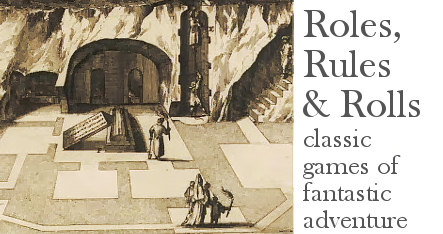One point, left dangling from
my recent series, I'd like to address: When should a DM use an analog mode of task resolution based on player descriptions of actions in role and your rulings on them, and when should he or she use a digital mode, rolling dice against set skills and difficulties?
There's a great benefit to seeing the physical environment of an adventure for what it is, rather than an abstract map dotted with "trap" and "secret" symbols. A lot of task resolutions then become simple. Is there a naked, unworked stone corridor? Then any tripwires or pressure plates or door seams will be evident to anyone with two good eyes, even in flickering torchlight, when proceeding forward at the glacial pace of dungeon exploration. I mean, try not noticing everything there is to notice while taking a minute or more to examine a 12' stretch of corridor, 1st Edition AD&D style.
What if the task is more difficult? Say there's a gossamer-thin tripwire spun by dark elves, or a seam of uncanny dwarven construction. Say there's a complicated bas-relief that could be hiding any number of buttons or holes, or a cracked floor with any number of outlines possible. For these, I would say that a long and close inspection would reveal the hidden feature. In player terms, they would have to give me a detailed description of what they are doing, and repeat that each time they are doing it.
Player attention, in other words, is a resource, drained by repetition and boredom. But
forget what I said about trying to model this with
limits on character attention. It's a player thing, not character. And player things, too, are analog.
If you want to reach the heights of immersion and intellectual challenge that come from an analog game, you have to trust your players to respect their time and enjoyment. You have to trust them not to abuse your system by giving long descriptions of detailed searches
at all times. If you're playing with dopey kids or grown-up asshats or hyper-task-focused fun-murderers, use a more rules- and dice-bound system - please!
You also have to resolve not to let them cheat their
way into this resource, using crappy min-maxer crutches like the
standing-order instruction sheet (see under "excel spreadsheet" anecdote there).This is just one of those times where you have to know what your group is like. Don't assume the worst right away. But don't think that the right system can substitute for mutual consent to have fun. Good players will fret about the possibility that an asshat could ruin the game, or even the possibility that they could be that asshat. But they won't actually do it.
Eventually, the environment will channel their attention. They'll zoom along a blank corridor or room in real time, because they know that any danger there will be spotted by their cautious in-game progress. They'll stop and check out mosaic floors, complex sculptures or patterns ... if they're wise. Your naturalistic, analog signaling of opportunities for complication will guide their attention. "Dwarven craftsmanship" or "illusionist's castle", of course, should spur them to new and temporary heights of paranoia.
Now, when do you roll? Yes, my game has a "notice detail" skill. And I use it for the same purpose as saving throws in
James M's classic analysis. It gives players a digital chance when their analog skills don't quite meet the challenge. Even if you're running down a corridor, you might notice the tripwire that your slow advance would make obvious. Even if you're just standing next to a bookcase casting idle eyes on it, you might notice the odd jointwork that sends you looking for an opening device.
There's one caution, though: I haven't yet had players get up to the point where their skill in notice detail becomes near-automatic. In my system a rogue could get there by level 4, though at the cost of everything else roguely. With more even development they're likely to max out the Notice skill around level 8.
I'm not sure whether the greater chance of success at those heights is a just reward for sticking it through, or a blow to the fun in analog gaming. Perhaps the balancing factor is this: At higher levels, you're more likely to face complex, brain-challenging mechanisms and effects, so that the challenge is not whether you see them, but what you do once you see them.












